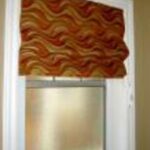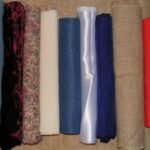DIY roman shades are an inexpensive way to express your own style and only required the simplest of sewing techniques. At its simplest a roman shade is piece of fabric hung from the top of a window casing, long enough and wide enough to cover the window glass, with a system of cords attached to the back to raise and lower the shade. When raised, the fabric lays in a soft swag when made from sheer fabrics and soft horizontal folds or pleats which stack one on top of the next when made from sturdier fabrics.
With the method detailed below, you will only need a few supplies and a hour or two to make your own roman shade. The following instructions for making roman shades work very well for roman shades made from sheer fabric where you would like the light to filter through and not be completely blocked by the shade. This type of roman shade works best for medium to narrow windows (up to 36 inches wide) mounted to fit inside the window casing. This is the most unstructured type of roman shade and requires the least supplies.
For each roman shade you will need: a piece of sheer fabric, matching thread, shade cord, 1 eye screw per cord, 1 small brass ring per cord, small plastic rings, a yard stick or similar piece of wood, 1 cord cleat, and 1 or more small sew-in weight per cord. I have found these items readily available and relatively inexpensive at my local sewing store, such as Jo-Ann Fabrics, and hardware store.
Instructions for making roman shades:
Step 1: Measure the window for mounting the shade inside the casing.
Step 2: Cut the fabric allowing 2 additional inches for hems on all sides. To do this add 4 to both the width and length measurements for the finished shade. Make sure you square the fabric and cut on the grain.
Step 3: Determine cords and rings to use and the placement. A single cord on each side of the shade works well for windows up to 24″ wide. For shades wider than 24″ or if you would like the shade to drape into two or three swags instead of a single swag, you will need another cord or two. Each cord will be cut to a length equal to the shade “length + width + length”. The cords will be laced beginning at the bottom of the shade, up through the rings to the top of the shade, across the top of the shade to one side and then allowed to hand down from the top.
Now for the rings. A brass ring is used as the top ring for each cord since the most pressure is placed on this ring. You can use brass rings totally, or you can use plastic rings for all others. Rings are placed in horizontal rows up the shade. When the shade is raised, the fabric will fold along these horizontal rows. The closer the horizontal rows of rings are to each other, the smaller the shade folds will be. Likewise, the further apart the horizontal rows of rings are, the deeper the folds will be and for a sheer roman shade the deeper the bottom swagging will be. Each fold will be equal to one-half the distance between the rows of rings. Placing the rings 6 inches apart will give narrower folds of 3 inches while placing the rings 12 inches apart will yield very deep folds of 6 inches.
Step 4: Get the supplies together. Now that you know how many cords and how many rows of rings you will use, you can purchase any supplies you do not have on hand. You will use a brass ring for each cord at the top of the shade, a plastic ring for each cord at the bottom, and then enough additional rings for each cord to give the desired draping. You may need to adjust the number of rings per cord slightly, based on the shade length.
For the sew-in weights, I have found flat donut shaped weights work best.
Step 5: Putting it together. First, hem the sides and bottom. Lay the fabric down with the wrong side facing up. Fold back 2″ along both sides and the bottom of the shade, pinning in place. Iron along the 3 edges. Working along a side, now fold the 2″ strip of fabric in half, tucking 1″ under and iron to crease. Do the same on the other side and then along the bottom. Unfold at the bottom and up each side a few inches from the bottom. Cut out the 1″ square outlined by the creases at each bottom corner. This will reduce the thickness and will make the bottom corners easier to iron flat. Along the bottom and up along the sides where unfolded, fold the first 1″ back along the crease line. There should be no overlapping with the sides yet, since the 1″ squares were cut out at each corner. Now fold the next 1″ along the crease lines created when ironed. At each bottom corner, fold the corners and tuck under to create a diagonal line – so the sides meet the bottom at the outer corner diagonally up to the inner corner of the hem. Pin in place. Sew the hem beginning 2″ down from the top, down one side, across the bottom, and up the other side, stopping 2″ short of the top.
Cut the yard stick or piece of wood to a length equal to 1/4″ less than the width of the shade. If using a yard stick, you may need to paint it a suitable color if it will show through the sheer fabric. With the shade laying flat, wrong side up, position the wood strip across the shade, with the top edge of the wood even with the top edge of the shade. The extra fabric for the hem should extend above the wood, fold it down over the wood strip, tucking the raw edges under and pin in place. Slip stitch the hem in place along the bottom of the wood strip as well as on both sides.
Now, on the back of the shade, mark the positions for the cord rings. Sew the rings onto the shade, using the brass rings for the top row and plastic rings for all other rows. Place the bottom row of rings 1/2″ in from the edge and sew the weights onto the bottom hem below the rings. Cut the cord into the pieces needed, tie the cords to the bottom row of rings, lace each cord up through all corresponding rings to the top and then lace all cords through the brass rings over to one side. Straighten the shade so it is laying flat and tie the cords together about an inch past the brass ring.
Step 6: Hanging the shade. Hold the finished shade up to the window and mark on the underside of the top window casing across from each brass ring. Screw the eye screws in at each marking so they suspend straight down. Install the cord cleat. Using a needle-nose pliers, open the brass rings just enough to slip each over the corresponding eye screw, and pressing the brass ring closed once it is slipped over the eye screw. Straighten the loose end of the cords and tie together again just below the cord cleat or at the desired length.




